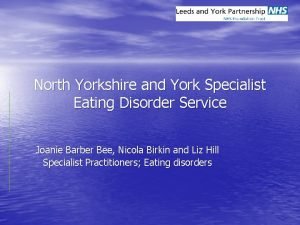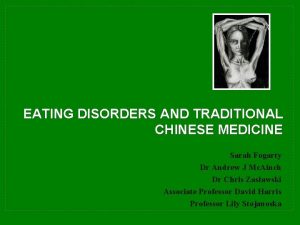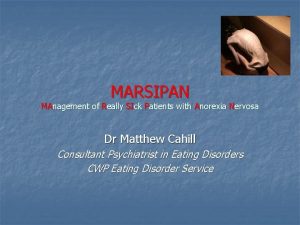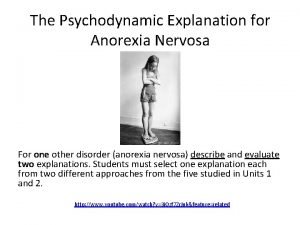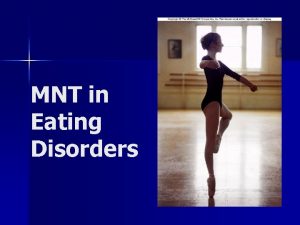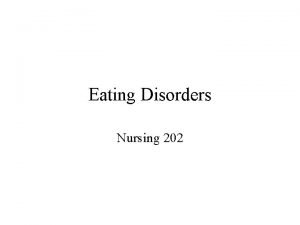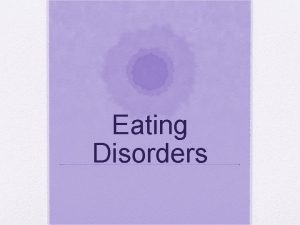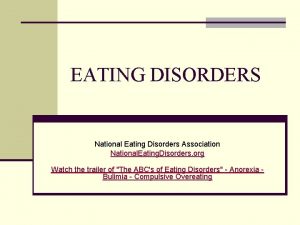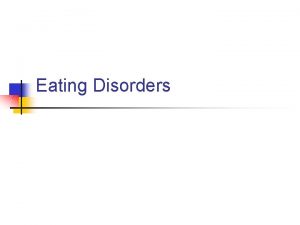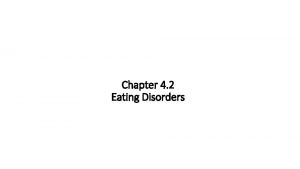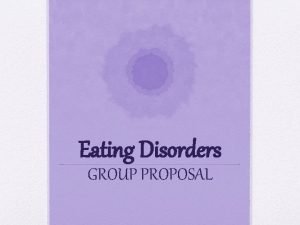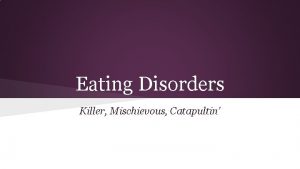Eating Disorders Lesson 5 Mr Royer Unhealthy Eating










- Slides: 10

Eating Disorders Lesson 5 Mr. Royer

Unhealthy Eating Behavior Limiting yourself to certain foods-no fat diets Ø Skipping meals –Fasting or starvation diets Ø Eating large amounts at one timeoverindulging Ø ProblemsØ • • • Affect ability to focus or learn Disrupt growth and development May lead to an Eating Disorder

Over exercising Ø Ø Ø Are overly concerned about their body and weight Have a unhealthy body image and low self-esteem More focused on athletic ability Ashamed of their diet and over exercise to compensate Problems: • • • Increased risk of injury Extreme tiredness Sadness or depression Problems concentrating in school Irritable and moody

Eating Disorders Eating disorder – A disease that involves an unhealthy concern with one’s body weight and shape. Ø Develop from unhealthy eating behaviors. Ø Affect those with low self-esteem, depression or victims of abuse. Ø Affect boys and girls from all races, cultures and income levels. Ø Symptoms: Ø • An obsession with their weight, bodies or food • Drastic weight loss over a short time

Anorexia Nervosa Anorexia nervosa- an eating disorder that involves starvation, an unhealthy body image, and extreme weight loss. Ø 1 in every 100 teen girls develops anorexia Ø They feel fat all the time even though they are thin. Ø Appear as perfectionists but, really have low self-esteem and unhealthy body image. Ø

Bulimia Nervosa – When a person eats a large amount of food, binge eating, and then tries to remove it , called “purging" usually by vomiting. Ø Also will use laxatives and diuretics and over exercise. Ø Dangers- Damage to digestive tract, and esophagus from stomach acids. Ø Puts stress on the body and can cause death. Ø

Bulimia Symptoms Obsession with food. Ø Steal food Ø Trips to bathroom immediately after eating Ø Forcing themselves to throw up after eating Ø Hiding food Ø Excessive exercise behaviors Ø Treatment- Doctors and food counselors Ø

Binge Eating Binge eating disorder- A person cannot control how much they eat. Ø Eat a lot of food quickly and do not purge. Ø Do not usually enjoy the food. Ø Eventually become obese- over 30% body fat. Ø Other related problems- high cholesterol, high BP, diabetes, gall bladder and heart disease, stroke and cancer. Ø

Giving and Getting Help Ø Ø Ø Ø Ø GIVING: Talk to them privately. Tell them you are concerned. Encourage them to get help. You can get them help. Talk to an adult. GETTING: Most will not recover without professional help, 20% die Talk to an adult you trust. Sit down and talk privately and express your concerns With help: 60% recover, 20% improve, 20% no change

Body Mass Index Ø BMI- A calculation to determine your healthy weight range. P. 559 in book Ø BMI= Weight in pounds x 704. 3/ ht in inches*squared Ø Example- 98 x 704. 3/56 squared=22. 0 Ø Find your age/BMI on chart-p. 559


